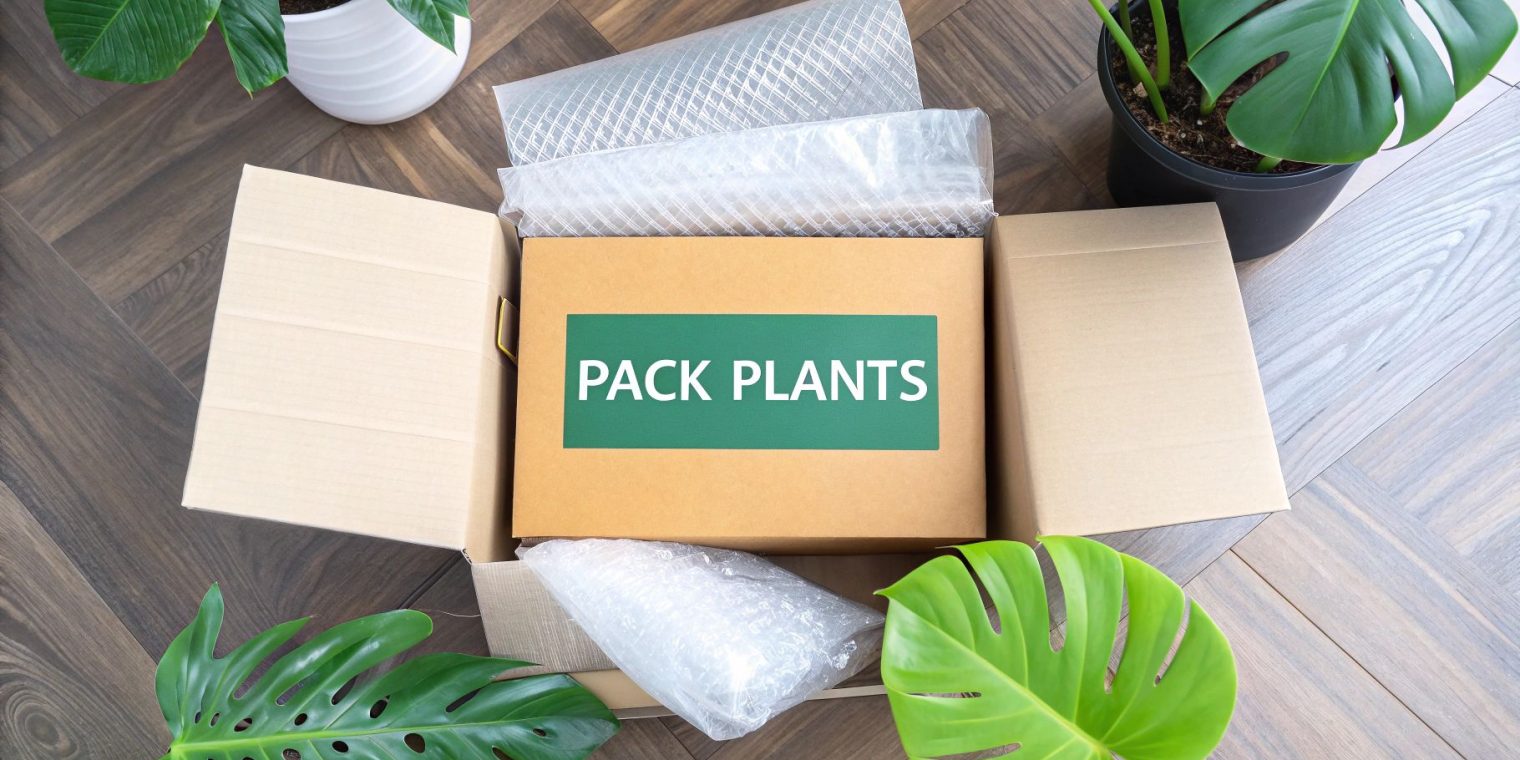Moving your plants successfully all boils down to a simple, three-part process: prune them about a week before you move, stop watering two days out, and pack them with care on the day. This straightforward approach is the best way to minimise plant stress and avoid messy soil spills, making sure your green friends arrive happy and healthy at your new Perth home.
Your Essential Plant Moving Checklist
Moving house with plants in tow doesn't have to be a headache. I’ve found that a successful plant relocation is all about good timing and a little bit of prep work. By following a clear timeline, you can sidestep common problems like transplant shock, snapped stems, and dreaded soil spills all over the moving truck.
It’s really about giving your plants their best shot at settling into a new place without too much drama. You wouldn't just toss your fragile glassware into a box without wrapping it, right? Your plants deserve the same thoughtful care. This isn't just about boxing them up; it's a process that should ideally start a few weeks before the big day.
The Week-by-Week Breakdown
To make it as simple as possible, here's a visual guide breaking down the essential pre-move tasks. Spacing these jobs out means no last-minute panic, and it’s a whole lot better for your plants' health.
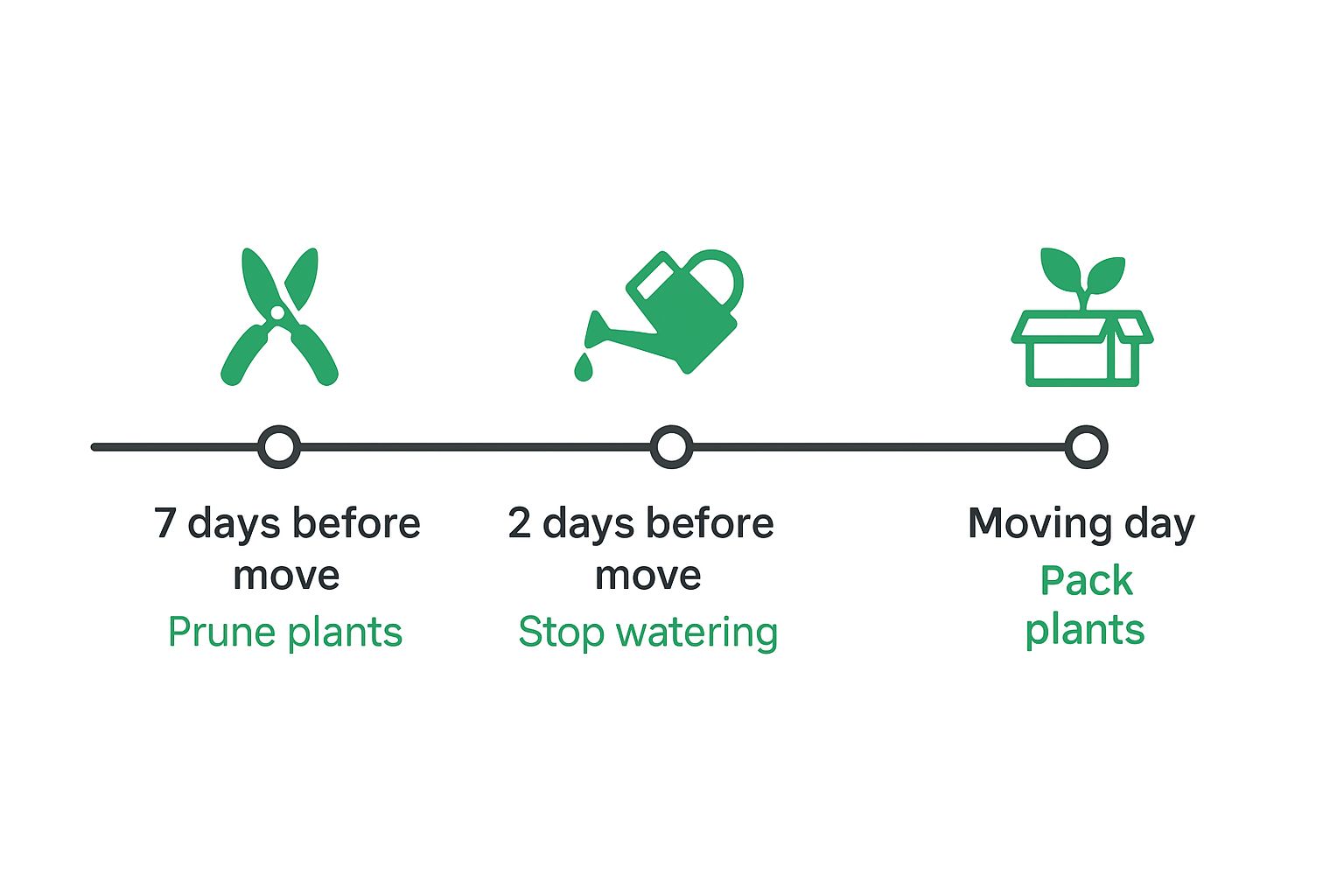
As you can see, getting these things done in stages is the key to a smooth transition.
Plant Moving Timeline: Your Week-by-Week Action Plan
For those who like a more detailed plan, this table breaks down exactly what to do and when. Follow this timeline to prepare your plants for a stress-free move, ensuring they are healthy and ready for transport.
| Timeframe | Critical Actions | Main Goal |
|---|---|---|
| Three Weeks Out | Re-pot any plants from heavy ceramic or terracotta pots into lightweight plastic nursery pots. | Reduce weight for much easier lifting and prevent your good pots from breaking in transit. |
| One Week Out | Give your plants a good trim. Prune away any dead leaves, yellowing foliage, or overgrown branches. Do a thorough check for pests. | Make plants more compact and easier to pack. This also stops any unwanted critters from hitching a ride to your new home. |
| Two Days Out | Give your plants their final watering. You want the soil to be damp, but definitely not waterlogged. | Keep the plant hydrated for the journey while preventing root rot and mould from growing inside a dark moving box. |
| Moving Day | Carefully place each plant into a sturdy box. Use packing paper or old towels to cushion them and stop them from tipping over. | Secure your plants for a safe trip and protect their leaves and stems from getting bumped or broken during the move. |
Sticking to this schedule really takes the guesswork out of the process. It transforms what could be a chaotic task into a manageable set of steps, giving you and your plants a much better moving day experience.
Getting Your Plants Ready for the Big Move
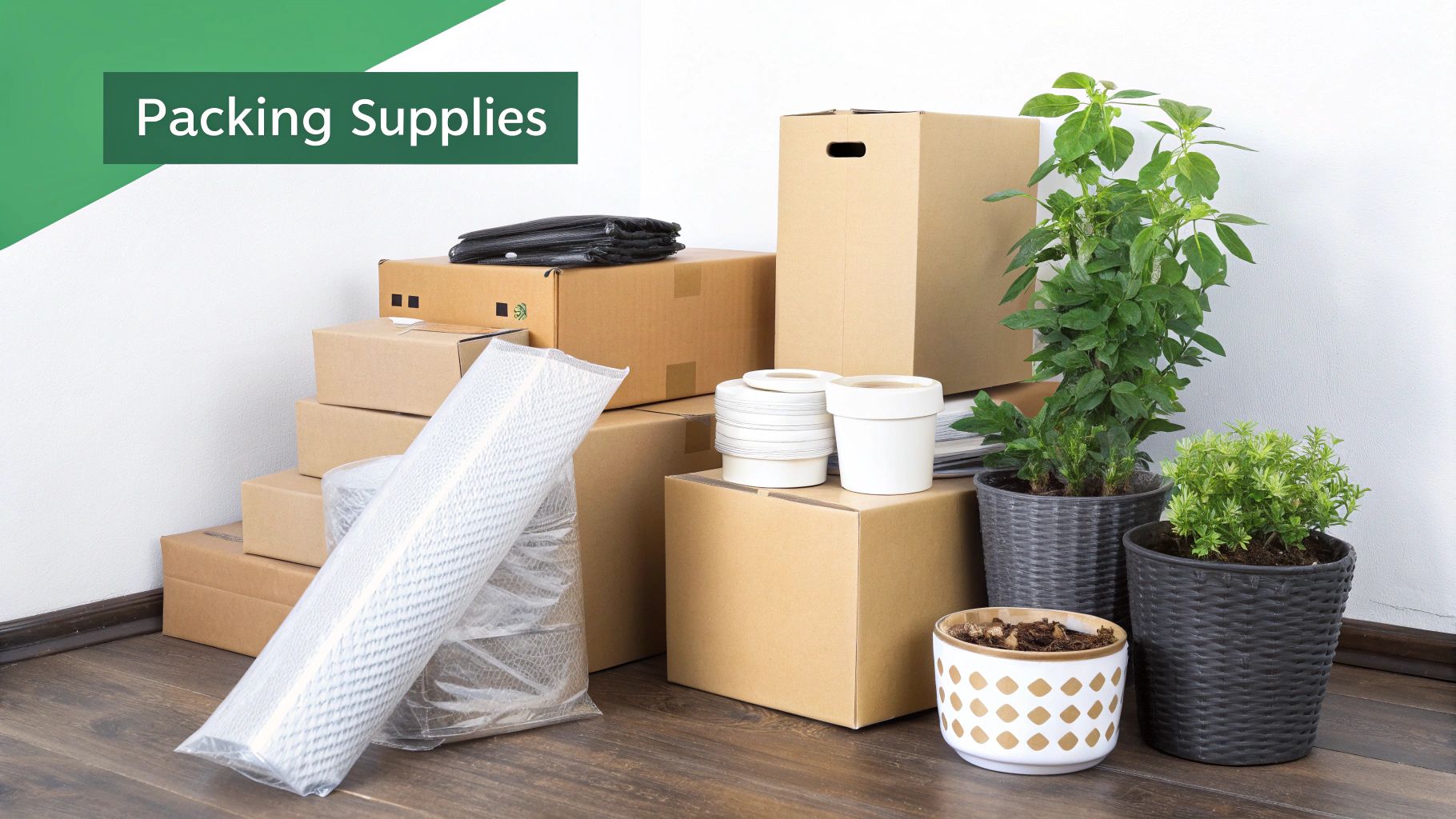
A successful plant move doesn't just happen on the day. The real groundwork is laid in the weeks leading up to your Perth relocation. This is your chance to get your green friends into top shape for the journey, ensuring they arrive at your new home happy and healthy.
Two to Three Weeks Out: Lighten the Load
Start by taking a look at their pots about two to three weeks before you move. Those beautiful, heavy ceramic or terracotta pots look fantastic on the shelf, but they're a removalist's nightmare. They add a surprising amount of weight and are incredibly fragile.
Do yourself (and your plants) a favour by repotting them into simple, lightweight plastic nursery pots for the move. This simple switch makes lifting easier and keeps your favourite decorative pots from getting chipped or broken in transit.
One Week to Go: A Tidy-Up and Health Check
About a week before the moving truck arrives, it's time for a little haircut. Pruning away any dead, yellowing, or leggy growth does more than just neaten things up. It makes your plants more compact and manageable to pack, and it helps them conserve energy for the trip ahead instead of supporting unnecessary foliage.
This is also the perfect moment to play detective and inspect for any unwanted hitchhikers.
Giving your plants a thorough check for pests before you move is non-negotiable. It’s an easy step to forget in the chaos of packing, but it prevents you from accidentally infesting your new home.
If you do find any little critters, you've got a week to deal with them. It’s always best to use plant-friendly pest control methods to sort out any issues without stressing the plant further.
The Big Picture: Timing and Travel
This prep work is crucial for any move, but especially for longer journeys across Australia. With a 66% net increase in people moving from cities since 2018, more and more plants are undertaking significant road trips.
Keep in mind that timing is everything. Plants, like people, find moving stressful. The shock of relocation is much less severe during the milder temperatures of spring and autumn, so if you have any flexibility, try to schedule your move then.
Gathering the Right Packing Supplies
Picking the right materials is what separates a successful plant move from a botanical disaster. This isn’t the time to grab any old box; you’re essentially building a small, mobile greenhouse for each of your plants to keep them safe on their journey across Perth.
The absolute foundation of this whole process is the box. You'll need sturdy, reinforced moving boxes that won't buckle under the weight of a damp pot and soil. I’ve seen too many people try to use flimsy grocery boxes only to have the bottom give out. Get a few different sizes to match your plant collection. If you're not sure where to start, this guide on where to buy moving boxes in Perth is a great resource.
What You'll Actually Need
You don’t have to spend a fortune here. In fact, you probably have most of what you need lying around the house.
Here’s your basic toolkit:
- Moving Boxes: Look for a box that’s a bit taller and wider than the plant. You want enough space for padding but not so much that the plant can slide around.
- Packing Paper or Old Towels: This is for filling the empty space in the box. It creates a snug buffer that stops the pot from shifting. I'd avoid bubble wrap for the leaves as it can trap moisture and cause damage, but it's fine to wrap it around the pot itself.
- Plastic Bags and Tape: This is my favourite trick. Just take a standard plastic shopping bag, wrap it around the base of the pot, and tape it to the pot itself. It’s the easiest way to keep soil from spilling everywhere in the truck.
I can't stress this enough: simple household items are often your best bet. An old towel provides fantastic, breathable cushioning for foliage and is way more sustainable than buying new materials.
For those taller, more awkward plants—I'm looking at you, fiddle-leaf figs and monsteras—you'll have to be a bit more creative. You can use extra cardboard to create supports inside the box or even gently tie the main stem to a small stake you've pushed into the pot. It might seem like a small thing, but it provides a huge amount of stability and can prevent the stem from snapping if the box gets bumped.
The goal is to make the plant and its pot move as a single, solid unit inside the box.
Packing Strategies for Different Plant Types
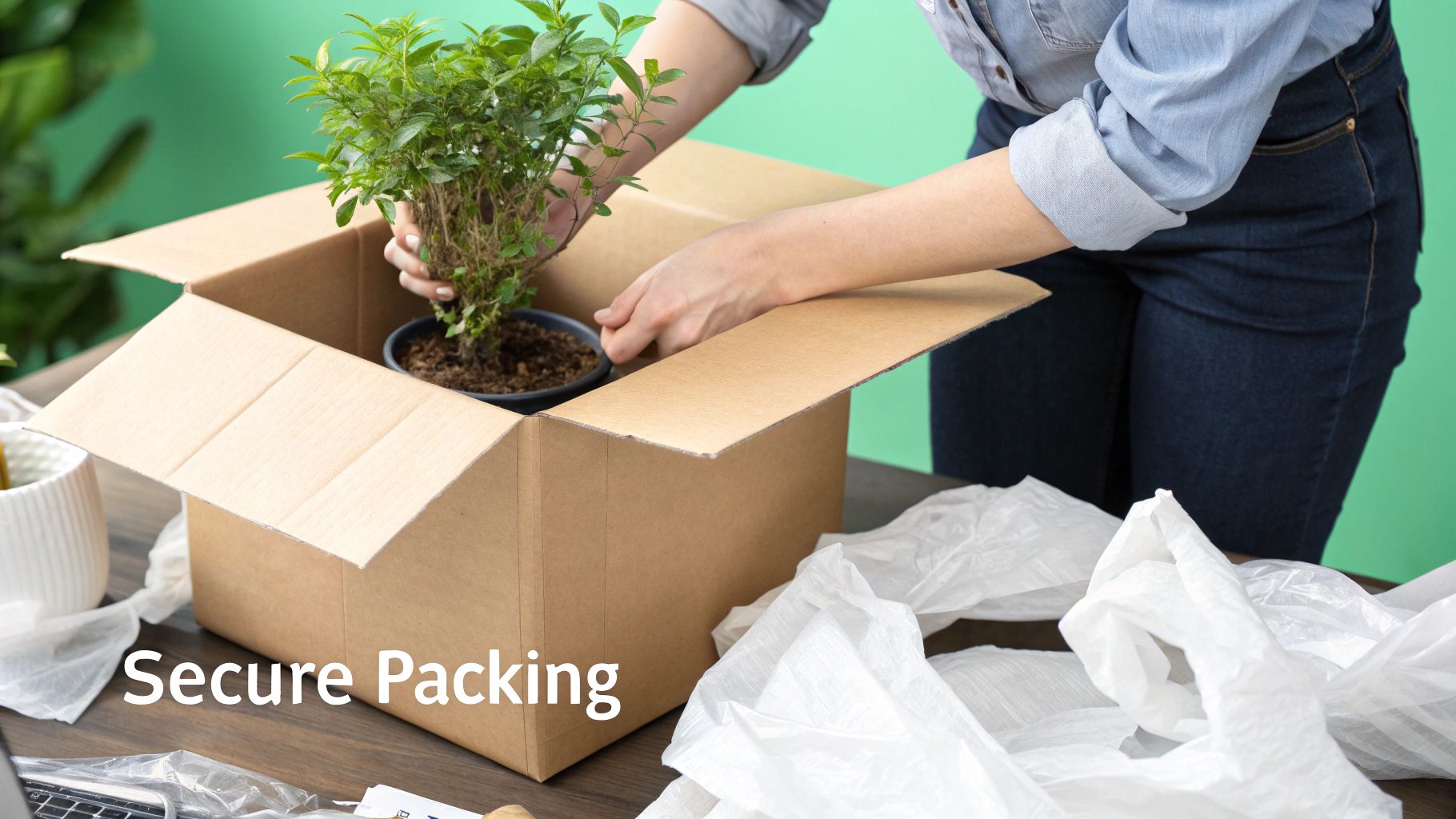
Let's be honest, not all of your plant babies are created equal. A one-size-fits-all packing method is a sure-fire way to end up with broken stems and very unhappy succulents. The key to successfully moving your plants is to tailor your approach to each one, from your towering fiddle-leaf fig to your delicate string of pearls.
It’s a bit like the care Australia shows for its national greenery. We plant nearly 70 million trees every year to replace those harvested, all part of a bigger goal to plant one billion new trees over the next decade. If we can put that much thought into the country's forests, we can certainly apply a bit of that same care to our own indoor jungles during a move.
Tall and Leafy Plants
I'm talking about your big statement plants—the monsteras, the fiddle-leaf figs, the birds of paradise. The biggest risk here is snapped branches and torn, bruised leaves.
- Bundle them up: Gently guide the branches upward and together, almost like you're giving the plant a supportive hug. Use soft twine or even fabric strips to loosely secure them. This makes the plant much more compact and less likely to snag on doorways.
- Wrap for protection: Cover the entire plant, from the pot rim up, with a protective layer. An old bedsheet, bubble wrap, or a large roll of kraft paper works wonders. This shield protects the foliage from bumps and scrapes on the journey.
Trailing and Vining Plants
Your pothos, philodendrons, or string-of-anything plants have their own set of challenges. Those gorgeous, long vines are incredibly fragile and can tangle or break in an instant.
Start by carefully coiling the vines on top of the soil inside the pot. The trick is to be gentle; don't wind them too tightly. Then, place the entire pot into a box, stuffing crumpled packing paper around the base to stop it from sliding. You can add some lightly crumpled paper on top of the coiled vines for extra cushioning.
A common mistake I see is people letting the vines hang out of the box. They inevitably get caught, crushed by another box, or snapped off. Make sure the entire plant, vines and all, is safely contained inside its own box.
Cacti and Succulents
When it comes to spiky friends like cacti, packing is as much about protecting your hands as it is about protecting the plant.
For cacti, your best bet is to wrap the plant in multiple layers of newspaper or even an old, thick towel, taping it securely in place. This creates a buffer between you and the spines. For your more delicate succulents, like echeverias, you can tuck cotton balls or soft tissue paper between the fleshy leaves to stop them from snapping off. Pack them snugly in a box with dividers so they can’t jostle around.
If tackling your plant collection feels a bit overwhelming, you don't have to go it alone. Looking into professional packing services in Perth can be a real game-changer, saving you a heap of time and stress while ensuring your green companions get expert handling.
Right, the big day has arrived. All that prep work you've done is about to make a huge difference. Now we get to the final, crucial part: the moving day shuffle and what to do once you and your leafy friends arrive at your new Perth home.
Moving Day: The Final Stretch
Here’s the golden rule I tell everyone: plants on last, plants off first. It's that simple. Make sure your plants are the absolute last thing loaded onto the removalist's truck and the very first thing you bring inside at the other end. This keeps their time in a dark, stuffy truck to a minimum.
If you’re taking them in your own car, even better. I always recommend placing the boxes on the floor or a seat, but make sure you wedge them in with towels or blankets. You don't want them tipping over every time you take a corner.
Unpacking and First Aid
Once you pull into the new driveway, ignore the urge to start on the kitchen boxes. Your plants need you first. Get them inside and start unboxing them straight away.
- Carefully remove any paper or plastic wrapping. Be gentle here.
- Do a quick inspection for any broken stems or leaves. A little bit of transit damage is normal, so don't panic.
- Group them all together in one spot for now. A laundry room or a sheltered corner of the living area is perfect – somewhere out of direct sun and away from any draughts.
Think of it like bringing them to a recovery room. Moving is a massive shock for a plant, and giving them a calm, stable spot to recuperate for a few days is the best thing you can do.
Settling In: The Acclimatisation Period
Now for the final and most important step: helping your plants get used to their new surroundings. Don't rush them into their permanent, sunny spots just yet. And please, resist the urge to give them a big "welcome home" drink of water. Their soil should still be just right from the watering you did a couple of days ago.
This slow introduction is more critical than you might think. We're seeing how sensitive plants are to environmental shifts all the time. In fact, projections suggest about 30% of Australian plant species may need to migrate south to cope with climate change. It’s a stark reminder of why we need to handle our own little ecosystems with such care during a move. You can read more about how climate change impacts Australian flora on phys.org.
Give your plants about a week in their temporary, sheltered spot before you start moving them to their final homes and getting back to a regular watering routine. A little patience now will ensure they don’t just survive the move, but truly thrive in their new space.
Your Top Plant Moving Questions, Answered
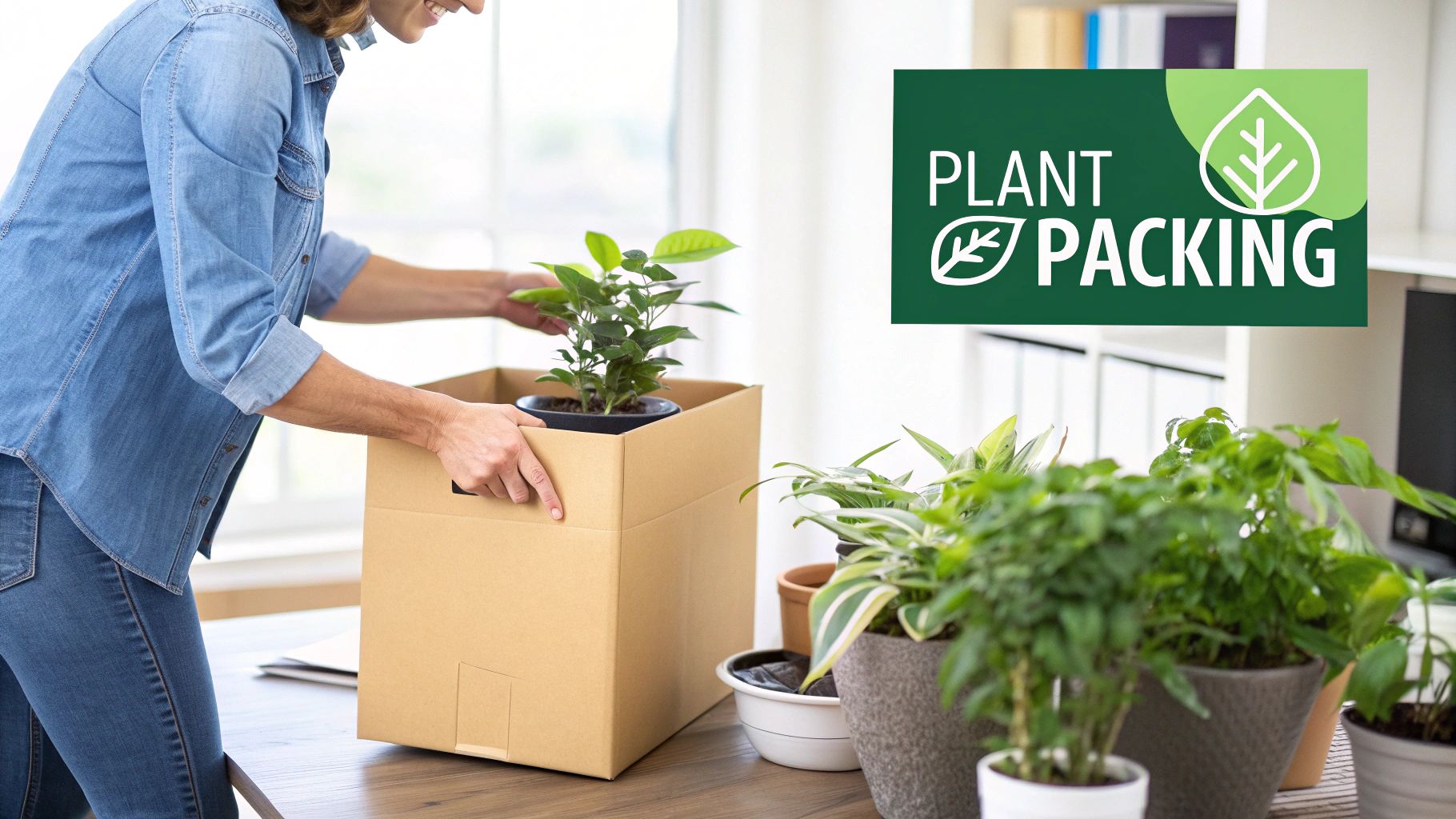
Even with the best-laid plans, moving day can get a little chaotic. When it comes to our beloved plant babies, a few common worries tend to surface right before the big day. We get these questions all the time, so let’s run through some quick, practical answers.
One of the big ones is about pots. Should I move plants in their heavy ceramic or terracotta pots? Honestly, I’d strongly advise against it. While you can, those beautiful pots are a massive liability during a move. They're heavy, awkward, and surprisingly fragile. The risk of them cracking or shattering in the back of a truck is just too high. A much safer bet is to repot them into lightweight plastic nursery pots a few weeks before you move.
Handling Those Awkward Transport Scenarios
Then there's the question of timing. How long can my plants stay in a moving box? You really want to minimise this as much as possible. A dark, stuffy box is a stressful place for a plant. Aim for no more than 12-24 hours max. This is exactly why we always say plants should be the last thing on the truck and the very first thing off at your new home.
And what about that giant fiddle-leaf fig in the corner? What’s the best way to move a really big or unusually shaped plant? This is where you might need to get creative and think beyond just using a box.
For a particularly large or precious plant, your best option is often to transport it yourself. Lay it gently on its side in the back of your car, cushioned with old doonas or blankets to stop it from shifting and snapping its stems.
Moving always throws up unexpected hurdles. If you're scratching your head over other parts of the process, it’s worth checking out the top questions about moving house answered by our experts.
A little bit of forethought makes all the difference. By working through these common issues before they happen, you’ll feel much more prepared to get every plant—from the smallest succulent to the tallest monstera—to your new place safe and sound.
Feeling overwhelmed by the thought of moving your entire home, let alone your precious plants? The team at Emmanuel Transport specialises in making your Perth move seamless and stress-free. Let our experienced removalists handle the heavy lifting with care. Get your free, transparent quote today!

